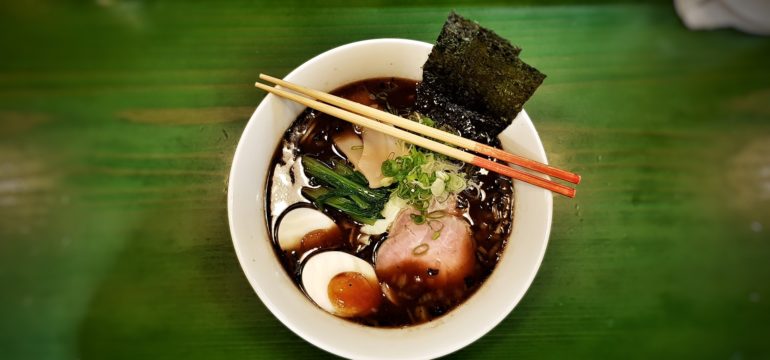By Bryan Quoc Le | 150 Food Science Questions Answered
Endless Tastes
We’re all familiar with the four basic tastes of sweet, sour, salt, and bitter found in our food. Some of us may have even heard of the term umami, which refers to the savory flavor of meaty dishes, and has been documented to stand alone as the fifth basic taste.1 While umami enhances the four other tastes, it has also found to possess its own unique savory element independent of the first four. Umami can be described as meaty, brothy, and savory.
Of those who were familiar with the idea of umami, even fewer people may have heard of kokumi, a newly minted taste concept that has been described as a “taste enhancer” that magnifies and lengthens all the other five previous basic tastes. Words that express the kokumi idea include continuity, mouthfulness, heartiness and thickness. Kokumi is believed to be involved in the sensation of mouth-coating, that satisfying (and hard to replicate) experience of butter, fats, and emulsions coating the tongue and mouth.2
The Flavor Chemistry of Umami and Kokumi
Both the umami and kokumi taste sensations are activated by amino acids or small peptides. Researchers postulate that umami and kokumi are evolutionary sensations that point to the presence of proteins and amino acids in a food, much like sweet is an indicator for carbohydrates, sour for acids, salts for minerals, and bitter for poisons. Umami flavor is strongly associated with the presence of the amino acids glutamic acid and aspartic acid. For a taste to be perceived by the brain, some molecule from a food or drink has to latch onto a perfectly designed receptor found on taste nerve cells on the surface of the tongue which causes the release of neurotransmitters and electrical signals that eventually tell the brain a particular sensation.
Taste transduction for umami is mediated by a class of glutamate-sensing receptors on the tongue’s taste buds.3 Additionally, these same receptors have been found to synergistically interact with some ribonucleotides in foods only when glutamate is available as well.4 Kokumi taste sensations are mostly connected with glutamyl-derived di- and tripeptides, such as the antioxidant glutathione present universally in all living tissues, especially meaty, muscular tissues. However, calcium-sensing receptors have been found to be responsible for experiencing the kokumi effect.4
On the other hand, drinking a solution of calcium salt alone doesn’t really do much for the kokumi experience, which anyone can attest to who’s ever tasted a piece of chalk.

The umamiest foods. Image Source
Umami, Then and Now
Umami was originally discovered by Professor Kikunae Ikeda of Tokyo Imperial University in 1908.6 While he was sipping on a bowl of dashi soup, he noticed a greater intensity in savory deliciousness after the addition kombu, a culinary seaweed native to Japan. He eventually isolated monosodium glutamate (MSG) as the amino acid responsible for the umami taste after extracting and recrystallizing components from twelve kilograms of kelp. He went on to commercialize the product by starting the Ajinomoto Company. He used acid-hydrolyzed wheat gluten protein as the starting material in the commercial process, rather than kelp, due to the high composition of glutamate found in gluten.

In Ikeda’s original discovery, it took him at least 6 major separation steps over a course of a whole year! Image Source
In another foray into umami science, an additional savory taste enhancer was discovered after by Ikeda’s protégé, Shintaro Kodama, who found that the ribonucleotide ionine-5’-monophosphate (disodium inosinate) elicited umami sensation in dried bonito fish flakes.7 Decades later, guanine-5’-monosphophate (disodium guanylate) was also discovered to produce umami flavor in shiitake mushrooms. While these substances alone add little umami to foods, a special synergy is generated when monosodium glutamate, inosinate, and guanylate are combined to give an enhanced burst of umami well beyond the sensation produced by glutamate by itself.
This synergistic property is responsible for the diverse combinations of ingredients found in notable cuisines around the world. For example, the savory combination of parmesan cheese and tomatoes (glutamate), and mushrooms (guanylate) in Italian dishes joins together high concentrations of these umami enhanced flavors. The meaty, refreshing broth of Vietnamese phở melds fermented anchovy sauce (inosinate) with charred onion, beef, and soy sauce (glutamate).
A New Kokumi Sensation
Kokumi is a more recent discovery also by the work of Japanese researchers in 1989.8 It was found that the addition of a pure, tasteless water extract of garlic evoked the kokumi sensation in a dilute solution of glutamate and inosinate. The extract alone possessed no flavor at the concentration threshold used, however, the addition of the two synergistic umami components brought out a noticeable garlic flavor to the extract with the characteristic mouthfulness associated with kokumi. Individual flavorless amino acid components of the extract were tested, and a similar response was found by taste panelists to varying degrees.
Since then, the quest to search for kokumi compounds has led to finding that glutathione, other glutamate-containing dipeptides and tripeptides, cysteine derivatives, histidine, and protamine all can achieve the kokumi effect. Intensive screening for kokumi-eliciting compounds within the glutamate family has found that γ-glutamyl-valyl-glycine, a tripeptide structurally similar to glutathione, is currently one of the most potent kokumi compound known with a sensory activity 12.8 times stronger than glutathione.9 Foods containing this powerful kokumi substance are still being discovered, but include fish sauce, yeast, soy sauce, shrimp paste, cheese, and even beer.
Health and Flavor
Recently, MSG and other flavor additives have been vilified by the general public as unnatural additives in foods and should be avoided due to their perceived toxicity or unhealthiness. However, there has been little clinical evidence to substantiate many of these claims when these additives are ingested at the levels found in typical foods.10 Many of these components are found naturally through fermentative or aging processes that break down proteins to smaller free glutamates and peptides, and are important flavor features in foods.
While the improvement of food flavor through the addition of MSG or other taste modifying ingredients has been strongly associated with unhealthy foods, research into umami and kokumi tastes has the potential to improve the lives of others. Taste research can be used to enhance the flavor of nutritious foods that are needed to feed malnourished people. Additionally, delicious flavors can be applied to medical foods for geriatric patients, whose taste buds have diminished in sensitivity over time and may require a significant boost to make their foods palatable.11
Understanding the sensory effects of umami and kokumi flavors in designing foods, healthy or not, will continue to have important impacts on how we perceive, taste, and choose foods in the future.
Want to learn more about flavor and food? Follow us on Instagram and Facebook for the latest research and articles on food science!
References
- Lindemann, B.; Ogiwara, Y.; Ninomiya, Y. (2002) The discovery of umami. Chemical Senses, 27(9): 843-844.
- Yamaguchi, S.; Ninomiya, K. (1998) What is umami? Food Reviews International, 14(2): 123-138.
- Chaudhari, N.; Roper, S.D. (1998) Molecular and physiological evidence for glutamate (umami) taste transduction via G protein-coupled receptor. Annals of the New York Academy of Sciences, 855: 398-406.
- Zhang, F. et al. (2008) Molecular mechanism for the umami taste synergism. Proceedings of the National Academy of Sciences of the United States of America, 105(52): 20930-20934.
- Ohsu, T. et al. (2009) Involvement of the calcium-sensing receptor in human taste perception. The Journal of Biological Chemistry, 285(2): 1016-1022.
- Kurihara, K. (2009) Glutamate: from discovery as a food flavor to role as a basic taste (umami). American Society of Nutrition, 90(3): 719S-722S.
- Uneyama, H.; Kawai, M.; Sekine-Hayakawa, Y.; Torii, K. (2009) Contribution of umami taste substances in human salivation during meal. The Journal of Medical Investigation, 56: 197-204.
- Ueda, Y.; Sakaguchi, M.; Hirayama, K.; Miyajima, R.; Kimizuka A. (1989) Characteristic flavor constituents in water extract of garlic. Food & Nutrition, 54(1): 163-169.
- Maruyama, Y.; Yasuda, R.; Kuroda, M.; Eto, Y. (2012) Kokumi substances, enhancers of basic tastes, induce responses in calcium-sensing receptor expressing taste cells. PLoS One, 7(4): 1-8.
- Walker, R.; Lupien, J.R. (2000) The safety evaluation of monosodium glutamate. The Journal of Nutrition, 130(4): 1049S-1052S.
- Fleming, Amy. “Umami: why the fifth taste is so important.” The Guardian 9 April 2013: Web. 31 July 2017.
 Bryan Quoc Le | 150 Food Science Questions Answered
Bryan Quoc Le | 150 Food Science Questions Answered
IFTSA VP of Digital and Social Media (2019-2020)
Bryan is the author of 150 Food Science Questions Answered (Rockridge Press, 2020) and a Ph.D. candidate in Food Science at University of Wisconsin-Madison studying the health effects of garlic and onion flavors. He received his B.S. and M.S. in Chemistry at the University of California, Irvine. In another life, he walked 2,000 miles from California to Louisiana in six months, and learned that eating tuna and peanut butter every day was not meant for the average human body. After he met his wife, he learned that there was more to good food than canned goods and smoothies. While not juicing onions and pressing garlic, Bryan likes to run half-marathons, discover interesting cuisines with his wife, and help entrepreneurs develop great food products.






1 Comment